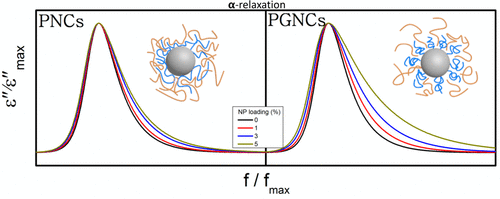当前位置:
X-MOL 学术
›
Macromolecules
›
论文详情
Our official English website, www.x-mol.net, welcomes your
feedback! (Note: you will need to create a separate account there.)
Wetting and Chain Packing across Interfacial Zones Affect Distribution of Relaxations in Polymer and Polymer-Grafted Nanocomposites
Macromolecules ( IF 5.1 ) Pub Date : 2020-06-26 , DOI: 10.1021/acs.macromol.0c00399 Emmanuel U. Mapesa 1 , Dayton P. Street 2 , Maximilian F. Heres 1 , S. Michael Kilbey 1, 2 , Joshua Sangoro 1
Macromolecules ( IF 5.1 ) Pub Date : 2020-06-26 , DOI: 10.1021/acs.macromol.0c00399 Emmanuel U. Mapesa 1 , Dayton P. Street 2 , Maximilian F. Heres 1 , S. Michael Kilbey 1, 2 , Joshua Sangoro 1
Affiliation

|
Polymers exhibit deviations from their bulk physical properties in the vicinity of solid interfaces due to changes in configurations, entanglements, and relaxation dynamics at the interfacial regions. By comparing grafted and nongrafted polymer nanocomposite systems based on poly(methyl methacrylate) and silica, we show that the distribution of relaxation times exhibits both commonly reported slower mobility and faster modes that depend on the nature of the interfacial zone, matrix molecular weight, and loading level of nanomaterials. These findings are derived from studies using broadband dielectric spectroscopy (BDS) and differential scanning calorimetry (DSC) to probe molecular and interfacial dynamics. By systematically examining nanocomposites based on nonfunctionalized “bare” Si nanoparticles (NPs) dispersed in PMMA matrices and on PMMA-grafted Si NPs (PMMA-g-NPs) in PMMA matrices, we probe the effects of interfacial interactions and confinement in each of these cases on the glass transition temperature, Tg, the mean time scales, and spectral shapes of the dielectric relaxation. The faster relaxation modes are attributed to the increasing importance of chain wetting and packing in the interfacial zones around nanofillers, especially in the polymer-grafted system. These insights are used to generate a unifying molecular framework that explains the enhancement in numerous macroscopic physical properties of polymer and polymer-grafted nanocomposites, which suits them for myriad applications.
中文翻译:

界面区域的润湿和链堆积影响聚合物和聚合物接枝纳米复合材料中弛豫的分布
由于界面区域的构型,缠结和弛豫动力学的变化,聚合物在固体界面附近表现出与其本体物理性质的偏差。通过比较基于聚(甲基丙烯酸甲酯)和二氧化硅的接枝和非接枝聚合物纳米复合材料系统,我们发现弛豫时间的分布同时表现出通常报道的较慢的迁移率和较快的模式,这取决于界面区的性质,基质分子量和纳米材料的负载水平。这些发现来自使用宽带介电谱(BDS)和差示扫描量热法(DSC)探测分子和界面动力学的研究。g -NPs)在PMMA矩阵中,我们探讨了在每种情况下的界面相互作用和约束对玻璃化转变温度T g,平均时间尺度和介电弛豫的光谱形状的影响。更快的松弛模式归因于在纳米填料周围的界面区域,尤其是在聚合物接枝体系中,链润湿和堆积的重要性越来越高。这些见解可用于生成统一的分子框架,从而解释聚合物和聚合物接枝的纳米复合材料在众多宏观物理性质方面的增强,从而使其适合多种应用。
更新日期:2020-07-14
中文翻译:

界面区域的润湿和链堆积影响聚合物和聚合物接枝纳米复合材料中弛豫的分布
由于界面区域的构型,缠结和弛豫动力学的变化,聚合物在固体界面附近表现出与其本体物理性质的偏差。通过比较基于聚(甲基丙烯酸甲酯)和二氧化硅的接枝和非接枝聚合物纳米复合材料系统,我们发现弛豫时间的分布同时表现出通常报道的较慢的迁移率和较快的模式,这取决于界面区的性质,基质分子量和纳米材料的负载水平。这些发现来自使用宽带介电谱(BDS)和差示扫描量热法(DSC)探测分子和界面动力学的研究。g -NPs)在PMMA矩阵中,我们探讨了在每种情况下的界面相互作用和约束对玻璃化转变温度T g,平均时间尺度和介电弛豫的光谱形状的影响。更快的松弛模式归因于在纳米填料周围的界面区域,尤其是在聚合物接枝体系中,链润湿和堆积的重要性越来越高。这些见解可用于生成统一的分子框架,从而解释聚合物和聚合物接枝的纳米复合材料在众多宏观物理性质方面的增强,从而使其适合多种应用。











































 京公网安备 11010802027423号
京公网安备 11010802027423号